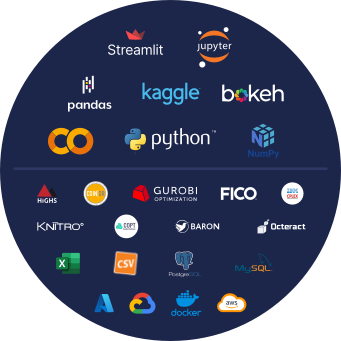Join us at INFORMS Business Analytics 2024 in Orlando, Florida
Find out why thousands of businesses, governments, research centers and educational institutions rely on AMPL to investigate and implement the most demanding large-scale optimization applications.
Join us at INFORMS Business Analytics 2024 in Orlando, Florida
Find out why thousands of businesses, governments, research centers and educational institutions rely on AMPL to investigate and implement the most demanding large-scale optimization applications.







AMPL has been developed for the real-world modeler who needs to manage all phases of the optimization development cycle without sacrificing computational performance. AMPLs straightforward language lets you formulate optimization models the way you think about them, and makes model logic accessible to your team members.
Natural mathematical modeling syntax with natural python integration. Our new python ecosystem allows you to collaborate, ideate, and prototype to build full optimization applications and deploy them to your larger systems.
Our amplpy interface allows developers to access the features of AMPL from within Python.
Use Jupyter Notebooks on platforms like Google Colab, Kaggle, Gradient, and AWS SageMaker. You can also easily communicate results with your teams through Streamlit.

Natural mathematical modeling syntax with natural python integration. Our new python ecosystem allows you to collaborate, ideate, and prototype to build full optimization applications and deploy them to your larger systems.
Our amplpy interface allows developers to access the features of AMPL from within Python.
Use Jupyter Notebooks on platforms like Google Colab, Kaggle, Gradient, and AWS SageMaker. You can also easily communicate results with your teams through Streamlit.
An industry-first approach to optimization
Express models the way you think about them. Change your data or solver without modifying your model. AMPL’s fast interpreter and mature APIs support the most challenging applications’ development, deployment, and maintenance.
Process your model and data with lightning speed to generate thousands or millions of variables and constraints. AMPL’s translation routines are tuned to the needs of optimization.
Master the AMPL language and system quickly with our introductory materials, examples, and documentation. The AMPL book provides a complete tutorial introduction (and it’s great for teaching, too).
Count on our team to help you in all stages of application building. Our technical staff provides expert advice on AMPL, solvers, and optimization. Our consulting services can help you build and integrate your models.

Our comprehensive Application Programming Interface provides an object-oriented callable library that lets you access AMPL models and run AMPL commands from broader applications. Data and results can be exchanged directly and efficiently between AMPL’s model entities and data structures in Python, R, C++, C#, MATLAB, and Java. Deploy AMPL models, embed AMPL in enterprise applications, program complex algorithmic schemes, and more.

Our comprehensive Application Programming Interface provides an object-oriented callable library that lets you access AMPL models and run AMPL commands from broader applications. Data and results can be exchanged directly and efficiently between AMPL’s model entities and data structures in Python, R, C++, C#, MATLAB, and Java. Deploy AMPL models, embed AMPL in enterprise applications, program complex algorithmic schemes, and more.
Innovative research starts here
Optimization has become a paradigm for an exceedingly diverse variety of problems in all fields of engineering as well as in physical and biological sciences, economics, and management.
Full-featured AMPL packages, including the most popular solvers, are available for academic research at discounts of 90% of the standard price list. Get our Community Edition to use AMPL for free (*internet connection required) with open-source solvers. AMPL also supports the free-for-research offerings of commercial solvers.


Optimization has become a paradigm for an exceedingly diverse variety of problems in all fields of engineering as well as in physical and biological sciences, economics, and management.
Full-featured AMPL packages, including the most popular solvers, are available for academic research at discounts of 90% of the standard price list. Get our Community Edition to use AMPL for free (*internet connection required) with open-source solvers. AMPL also supports the free-for-research offerings of commercial solvers.

We make it simple to learn and teach
AMPLs intuitive syntax, extensive resources allow educators to teach with ease and independent learners to start modeling on their own.
Free, Full–featured AMPL and Solvers directly on Google Colab. Use our collection of AMPL models in Jupyter Notebooks to assist your teaching.
Instructors can readily configure and distribute bundles of AMPL and popular solvers. They’re easy to install and operate without limitation throughout the duration of your course.

We make it simple to learn and teach
AMPLs intuitive syntax, extensive resources allow educators to teach with ease and independent learners to start modeling on their own.
Free, Full–featured AMPL and Solvers directly on Google Colab. Use our collection of AMPL models in Jupyter Notebooks to assist your teaching.
Instructors can readily configure and distribute bundles of AMPL and popular solvers. They’re easy to install and operate without limitation throughout the duration of your course.
The standard for optimization in industry
AMPL makes building optimization application simple, supportable, and accessible. It’s trusted in energy, finance, supply chain, and just about any sector where success depends on making well-informed decisions in a complex environment. We have users throughout the world in companies, agencies, and organizations of all sizes.
15,000+
AMPL license deployments worldwide
200+
Corporate and government organizations that optimize with AMPL
500+
Universities that use AMPL for teaching and research
1000+
Research papers that credit AMPL models
Get up and running with AMPL in minutes with a free Community Edition license. Or contact us to design a custom package for your project.
Use a Community Edition license to find the products you need. When you’re ready to purchase, compare all our licensing options for AMPL and commercial solvers.
Get started with our developers’ documentation site with examples and support with data exchange, APIs, and a whole range of AMPL plugins and features. Join the discussion on the forum for direct support from our team.